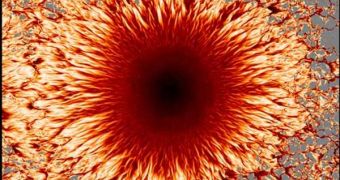Sunspots have been thoroughly analyzed over the past couple of years, as a low solar cycle minimum turned the attention of the astronomical community to the Sun. But, despite trying to explain how the formations appeared, very few experts were able to come up with believable theories as to what they were made of, and what their inner structure was. US experts from the National Center for Atmospheric Research (NCAR) in Boulder, Colorado, have recently used a supercomputer to create a series of sunspot simulations, which they say offer a better view of the complex dynamics that drive the dark blotches on the surface of the Sun.
“This is the first time we have a model of an entire sunspot. If you want to understand all the drivers of Earth's atmospheric system, you have to understand how sunspots emerge and evolve,” Matthias Rempel, one of the NCAR scientists who worked actively in creating the new simulation, explained. Space reports that the recent study could hold hints to devising more accurate estimates of how geomagnetic storms unleashed by these formations could affect our planet's climate patterns and communication systems.
An area larger than 31,000 by 62,000 miles (50,000 by 100,000 kilometers) was simulated in the supercomputer, with an average depth of about 3,700 miles (6,000 kilometers). The team also factored in the fact that sunspots appeared darker because they were cooler than the material they covered by about 3,000 degrees Fahrenheit, or 1,500 degrees Celsius. The research revealed that the magnetic fields inside the formation needed to be inclined in certain orientations, in order to allow for these complex structures to form.
“With this breakthrough simulation, an overall comprehensive physical picture is emerging for everything that observers have associated with the appearance, formation, dynamics and the decay of sunspots on the sun's surface,” NCAR expert Michael Knoelker added. Behind the new study was the National Science Foundation (NSF), which funded the research published online in the June 19th issue of the respected journal Science. The team used a bluefire supercomputer at the Center of their investigations, which was confirmed by readings collected from telescopes in orbit and on the ground.

 14 DAY TRIAL //
14 DAY TRIAL //